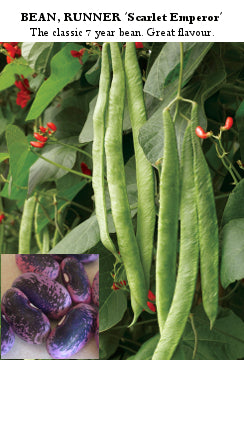How to Runner Beans
The essential guide to growing kale from seed; with notes on germination, cultivation, harvest and even kitchen uses.

Seeds per gram (Sds/g): 1–2
Feed Requirements: Low
Growing Notes:
Position & Soil
- Soil Type & Drainage:
- Prefers well-drained soil with moderate organic matter.
- Avoid boggy or waterlogged areas; roots can rot over winter if drainage is poor.
- Sun Exposure:
- Thrives in cooler conditions or partial shade, making it more heat-tolerant than some beans.
- Sheltered spots help protect plants from strong winds.
Sowing & Germination
- Seed Depth & Timing:
- Sow seeds about 3–5 cm deep once soil temperatures are consistently above 17 °C.
- Germination typically occurs within 7–14 days, depending on temperature.
- Method:
- Sow directly into the ground after the last frost in cooler climates.
- For an earlier start, sow in pots or modules indoors, then transplant once danger of frost has passed; or
- Soak beans in indoors in water overnight and plant out, this will speed up germination.
- Spacing & Support:
- Plants can be spaced 20-30 cm with rows 50-60 cm apart.
- Install sturdy stakes, trellis, or a teepee system of at least 2 m high before planting to avoid root disturbance later.
Cultivation & General Care
- Watering:
- Keep soil evenly moist, especially during flowering and pod development.
- Avoid waterlogging, particularly over winter if roots are left in the ground.
- Feeding:
- Runner beans require only light feeding—excessive nitrogen leads to lush foliage but fewer pods.
- Incorporate well-rotted compost or a balanced organic fertilizer into the soil before planting.
- Perennial Habit:
- In climates where temperatures stay above -3 Co and the soil is well-drained soil, runner beans can survive winter and resprout in spring (hence the nickname “7-year bean”). Cut back once frosts start or when the beans stop growing.
- If winters are harsh or the soil is poorly drained, roots often will not survive.
- Wind Protection:
- Runner beans are vulnerable to wind damage.
- Plant in a sheltered location or use windbreaks to prevent stems from snapping.
Potential Problems
- Wind Damage:
- Stems and leaves can be battered by strong gusts. Choose a protected site or provide screening.
- Overwintering Losses:
- In colder climates or waterlogged soils, the perennial rootstock may not survive.
- General Pests/Diseases:
- Similar to other beans; keep watch for aphids, slugs, and snails.
- Avoid overhead watering late in the day to reduce fungal issues.
Harvesting & Storage
- When to Harvest:
- Pick pods continually while they are young and tender (roughly 12–20 cm long, depending on variety).
- Frequent harvesting encourages more pods and prevents beans from becoming fibrous.
- How to Harvest:
- Gently twist or snip pods from the vine to avoid damaging the plant.
- If pods become mature and develop large seeds, they can toughen, reducing eating quality.
- Storage Tips:
- Use fresh runner beans immediately for best taste.
- They can be blanched and frozen if harvests are plentiful.
- Some beans can be dried, stored and used when needed with soaking or cooking. See our White Dutch Runner Bean.
Additional Tips & Notes
-
Ornamental Value:
- Scarlet Runner varieties produce vibrant red flowers, making them both a food crop and ornamental plant.
-
Cooking & Eating:
- Runner beans are versatile—steam, stir-fry, or use in soups and casseroles.
- Smaller, tender pods are often sweeter and have better texture than larger, mature pods.
- Bush, Climbing, French and Soy Bean specific tips:
By providing ample support, ensuring good drainage, and harvesting frequently, gardeners can enjoy a prolonged crop of delicious runner beans while benefiting from the plant’s ornamental appeal.
Sowing Periods
| J | F | M | A | M | J | J | A | S | O | N | D | |
|---|---|---|---|---|---|---|---|---|---|---|---|---|
| Cool | ||||||||||||
| Temperate | ||||||||||||
| Sub-Tropical/Tropical |
Filters
2 products
Runner Bean 'Scarlet Emperor'
Sale price$3.75
Runner Bean 'White Dutch'
Sale price$3.75


